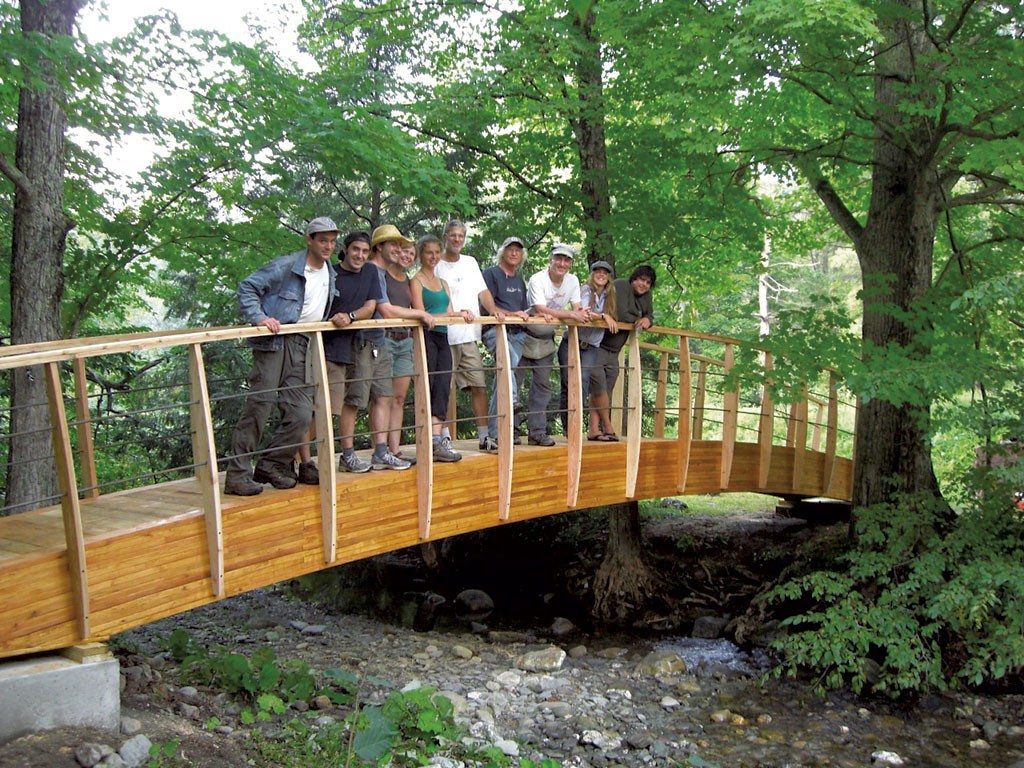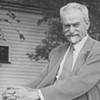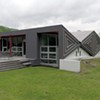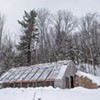
A bridge in Poultney constructed in 2011 with instructors Steve Badanes, Jim Adamson and Bill Biolosky
Published July 9, 2014 at 10:00 a.m.
The coinage "yestermorrow" conjures up a magical world outside of time, and in some respects Yestermorrow Design/Build School in Waitsfield actually creates one. Take its summer course, Design/Build for Public Interest. In less than two weeks, a dozen students take a concept — a pedestrian bridge, a composting privy, a trail shelter — and design, build and install it. Three days of collaborative design work, 10 more of construction, and — poof! — the public has a useful and typically eye-catching new facility.
This year's course project is a play structure-cum-outdoor classroom for Fayston Elementary School, just east of Waitsfield. Participants can be absolutely anyone; this writer, with zero credentials in design, architecture or building, was highly encouraged to apply. The class often attracts architectural students, recent graduates in the discipline and the occasional practicing architects who come to learn what their training doesn't teach them: how to turn design charrettes into real structures. But many other participants are interested in community giving or just want to learn how to build stuff.
Yestermorrow's renowned teachers make the magic happen. Design/Build for Public Interest (formerly Community Design/Build) is team-taught by three men. Architect Bill Bialosky, whose firm Bialosky & Partners has offices in New York City and Cleveland, has collaborated with Maya Lin — of Vietnam Veterans Memorial fame — on residences, a chapel and the Museum of Chinese in America in Manhattan, among other projects.
He's joined by Steve Badanes, who teaches at the University of Washington, and Jim Adamson, a visiting critic at the University of Miami. Badanes, Adamson and a third friend formed the design/build group Jersey Devil in the 1970s. The unorthodox houses they designed and constructed around the country over the next 25 years while living in job-site trailers made them "cult figures in the architecture world," according to a 2004 New York Times article on Badanes.
Reached at his Whidbey Island home near Seattle, Badanes explains that both Jersey Devils and Yestermorrow, where he has been teaching since 1982 (two years after John Connell founded the school), have their roots in the Mad River Valley's design/build movement of the 1960s. That's when David Sellers and other disenchanted Yale architecture graduates bought up land cheaply and began doing what architects hadn't done for years: building — and not by the rules. The result was Warren's Prickly Mountain, a collection of alternative-energy-powered residential assemblages of wild shapes and angles, each built to solve a series of design challenges, rather than from a master plan.
Badanes, who earned his master's in architecture from Princeton in 1971, quips, "If you were an architecture student in the '60s, you knew about Vermont." On a trip to see a house in Stowe by Sellers, he realized the latter was "using architecture to have fun." That convinced Badanes to pursue the design/build path rather than labor at a desk to become licensed.
Badanes eventually bought four acres near Warren from Sellers "in a fire sale in the early '80s." During the design/build public-interest course — which he has taught every summer for the past 20 years — he stays on the undeveloped plot in a 1954 Prairie Schooner trailer whose roof has been raised. The residence "looks like a gypsy wagon," is known to Yestermorrow staff as the Secret Location and generally becomes a "two-week party" site, says Badanes with a chuckle. He brings students to view its composting toilet if they're building one that year.
Last year's project was, in fact, a composting toilet for Shelburne Farms to replace its porta-potties. The nonprofit's cofounder, Marshall Webb, has solicited a number of projects from the class, including a produce wagon for farm sales and a mobile writer's cabin whose honorary first guest was environmental activist Bill McKibben. According to Yestermorrow executive director Kate Stephenson, staff members choose projects from among requests by numerous local nonprofits. The client pays for materials — mostly locally milled wood because "it's easy to teach," says Badanes. Labor is provided free of charge.
One student who helped design and build Shelburne Farms' privy last year was Bonnie-Kate Walker, a former Yestermorrow intern whose interest in design and landscaping led the Tennessee native almost accidentally to the Vermont school.
"I kind of just found it on the internet," recalls Walker, 25, reached while driving through Kansas on a cross-country move to Virginia, where she'll start earning a master's in landscape architecture at the University of Virginia in the fall.
The instructors at Yestermorrow impressed Walker. Badanes and his colleagues run the design-charrette process so democratically that "everyone ends up feeling like they designed the structure," she comments. "Then you start building, and there's just no endpoint. You start at 8 [a.m.], and you end at 11 at night. You're just so invested in getting this done."
Walker appreciated equally the instructors' push toward creative inventiveness and the practical skills they imparted. "After that class, I totally feel like I could whip up a shed on my own," she declares.
Badanes says the point of the course is "for everyone to have a good experience. But," he adds, "some of the projects really are beautiful."
INFO
Design/Build for Public Interest, Yestermorrow Design/Build School, August 3 to 15. Tuition: $1,750. yestermorrow.org
The original print version of this article was headlined "At Yestermorrow, Instructors and Students Design/Build for Public Good"
More By This Author
Speaking of...
-

Q&A: Art Entrepreneurs Tessa and Torrey Valyou Celebrate 15 Years of New Duds
Oct 11, 2023 -

Video: A Tour of New Duds With Torrey and Tessa Valyou at Their Screen-Printing and Embroidery Shop in Colchester
Oct 5, 2023 -

Video: Exploring Ken Mills’ Secret Sculpture Garden
Jun 29, 2023 -

State Wants to Sell Downtown Burlington Office Building
Jan 24, 2023 -

Bill Truex, 'Citizen Architect' Who Designed Burlington's Church Street, Dies
Apr 12, 2022 - More »
Comments
Comments are closed.
From 2014-2020, Seven Days allowed readers to comment on all stories posted on our website. While we've appreciated the suggestions and insights, right now Seven Days is prioritizing our core mission — producing high-quality, responsible local journalism — over moderating online debates between readers.
To criticize, correct or praise our reporting, please send us a letter to the editor or send us a tip. We’ll check it out and report the results.
Online comments may return when we have better tech tools for managing them. Thanks for reading.














































